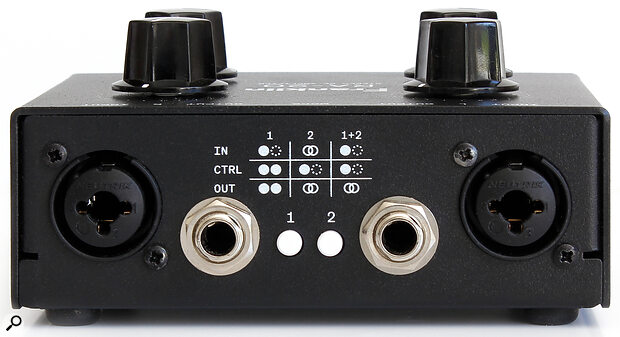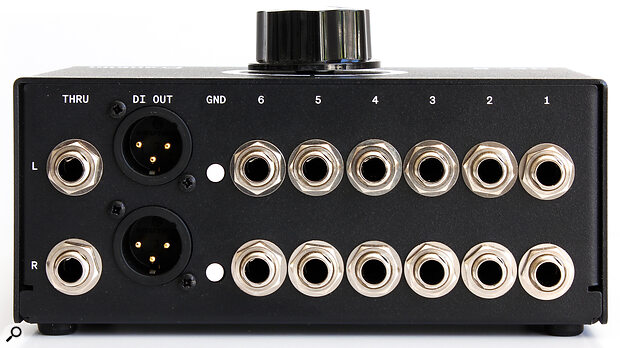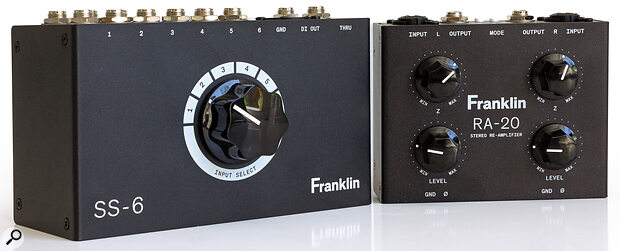We check out a cleverly configurable re‑amper, and a switch box with a difference...
Franklin Audio offer a small range of handy problem‑solving devices that are all designed and handmade in Syndey, Australia. Alongside a couple of DIs and a speaker switch, there are two re‑amp boxes and a stereo input switcher boasting some useful facilities that I think make it unique. I was sent the stereo version of their re‑amper, the RA‑20, and the SS6 MkII stereo switcher for evaluation. They came generously packaged to protect them from damage in transit, and both take the form of a two‑part, black, 1.5mm folded‑steel rectangular box, with most controls on the top panel and four rubber feet securely attached to the base with screws. The labelling is similarly no‑nonsense, the crisply printed white‑on‑black text and markings being easy to read against the black. One might summarise all that by saying these boxes are compact and robustly constructed, with a pleasingly understated, utilitarian aesthetic. All of which is a good thing in my book...
The Re‑amper
I’ll take the RA‑20 re‑amper first, since that’s probably the simpler device to describe. Passive re‑amping might not be rocket science, but it’s executed nicely here, with custom‑wound Franklin Audio transformers at its heart, and while this box essentially puts two of the company’s RA‑10 single‑channel re‑amp circuits in one box there are some thoughtful additional touches in this two‑channel version.
Two Neutrik Combi sockets on the back allow you to connect sources using three‑pin XLRs or quarter‑inch jacks, and two quarter‑inch TS jack outputs can pass the signal on to your stompboxes or amps. Nestling between the RA‑20’s sockets are two buttons that let you select different channel‑configuration functions, helpfully indicated in a simple diagram above. The four options are: dual mono (whereby both channels remain completely separate); mono (left channel only) to dual mono, with separate controls for each channel; stereo, whereby both channels are used, but the left channel’s controls govern the behaviour of both; and mono to stereo, whereby the left input is split to two outputs, and the controls for those outputs are linked in the same say as in stereo mode. On the top are two knobs per channel, the upper one operating a pot to vary the input impedance to suit (or, potentially, change the character of) a source, and the lower one setting the level at the output. Below, on the front panel, are two buttons for each channel, one a ground lift and the other a polarity inverter.
 The RA‑20’s two channels and control set can be configured to suit the task in hand.
The RA‑20’s two channels and control set can be configured to suit the task in hand.
And that’s pretty much all there is to it from a user point of view. The knob positions are super easy to see, as is the in/out status of the various buttons on the front and rear (though, being on opposite panels, note that you can’t see the status of all of them at once). And there’s an incredible amount of flexibility on offer here for such an apparently simple box — the control linking in particular makes more sophisticated re‑amping setups very easy to implement. As you’d expect of a well made passive re‑amper with high‑quality components, there’s low noise (SNR >90dB) and distortion (THD <0.001%) and the frequency response is pretty much flat (10Hz‑30kHz ±1dB).
There are numerous possible applications for this box, outside of traditional re‑amping. You could, for example, use it in mono‑to‑dual‑mono configuration to re‑amp to two amplifiers simultaneously, using the channels’ separate level controls to hit the sweet spot of each amp. Alternatively, it’s a perfect means of hooking up a buffered stereo stompbox effect with an instrument input and line‑level output (like so many digital pedals are today) to your audio interface: stereo line‑level balanced out from your interface to the balanced inputs of the RA‑20; unbalanced instrument level out from the RA‑20 to the pedal; then from the pedal’s line outs back to your interface — and, of course, you could have more than one stereo pedal in that chain. In that scenario, it’s great to have the balanced inputs, as with suitable cables this will help to keep noise to a minimum if your audio interface is placed some distance away from your pedalboard. And the technical performance means it’s suitable for sending all manner of signals out of your DAW to process with pedals: if you want to hear a snare through a RAT distortion, or a vocal through your bucket‑brigade delay pedal, you can do that.
A Switcher To DI For?
In a similar vein, the SS‑6 is essentially a switch in a box — so a simple idea — but Franklin have taken the opportunity of adding some useful features for the user’s convenience. At first glance, it resembles the Heritage Audio Synth Buddy I reviewed in SOS June 2025, but while Franklin’s box (which I believe came to market first) is a little more expensive, I don’t think the price unreasonable because it has a few more tricks up its sleeve.
Like the Synth Buddy, there’s a big selector knob on the top panel, and the inputs are arrayed across the back panel: there’s one row each of six quarter‑inch TS jacks for the left and right channels, respectively. The Synth Buddy offers more inputs (10), but has only one output. The SS‑6, on the other hand, has balanced XLR DI outputs that can be routed to, for example, valve or transformer‑equipped mic preamps for a little extra flavour, and there are also left and right Thru jacks that you can use you to pass the signal on to other unbalanced destinations locally. There’s also a ground‑lift button for each channel, should you need it. And as with the RA‑20 (and the Synth Buddy for that matter), everything’s passive — the DI part of the equation employs a pair transformers that are again custom wound by Franklin — so you don’t need a power supply. The frequency response is quoted as being 10Hz‑40kHz (within 1dB), and the signal‑to‑noise ratio and THD are the same as for the RA‑20.
 As well as routing unbalanced sources to different destinations, the SS‑6 can act as a transformer‑based stereo DI.
As well as routing unbalanced sources to different destinations, the SS‑6 can act as a transformer‑based stereo DI.
In operation, I found the SS‑6 just as intuitive as I did the Synth Buddy, and if you have several outboard instruments and an audio interface with only two inputs, something like this could be so convenient, taking up less space than a mixer and being more immediate to use than a patchbay. While there may be fewer inputs to choose from than on the Synth Buddy, the dual outputs open up rather more applications. For example, I was able to use it as a simple splitter, patching my Roland Juno‑6 into the inputs and simultaneously routing it to a pair of mic preamps for colour, en route to my audio interface, and onward, via the Thru connectors, to my pedalboard for effects. I imagine a lot of people taking multiple synths, drum machines and the like on stage could find this splitting function really handy: you could hook the SS‑6 up to the FOH desk and have a local feed for monitoring, all with a single box that’s light and small enough to be portable. Another potential application would be in the studio, where you can hook up various instruments that you use regularly, and record the selected one both dry (with the DI outputs patched into your interface’s mic preamps) and, simultaneously, through effects, giving you the option to strike the optimum wet/dry balance later during mixing.
Boxing Clever?
I love both these Franklin boxes. Countless re‑ampers, switchers and other ‘problem solver’ gadgets make their way into my studio each year and lots of them have their merits. But these have clearly been designed by people who understand the practical needs of music‑makers as much they do the theory behind the gear.
They’re sturdy, they’re practical, they’re relatively small and lightweight, and they don’t screw up your sound.
They’re sturdy, they’re practical, they’re relatively small and lightweight, and they don’t screw up your sound. What’s more, they offer that little bit more than what they ‘say on the tin’. The clever channel‑control modes in the re‑amper impressed me particularly. Were I in need of such gadgets then, based on this experience, I’d certainly put any of the Franklin range on my audition list, and am happy to recommended them.
Summary
This admirable pair of problem‑solvers performs well and offers some really practical features.
Information
RA‑20 $295. SS‑6 $365.

